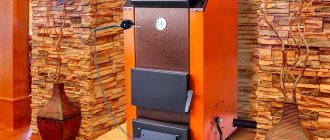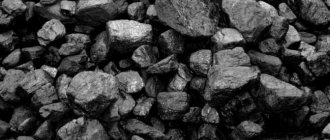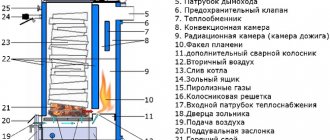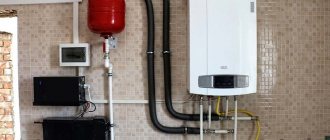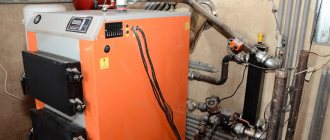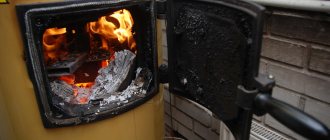The automatic solid fuel boiler is designed to operate in long-term autonomous mode, so the unit can be used in a heating system. In the absence of gas communications, this option is optimal. To decide on the purchase of a device, you need to know the features of its operation.
The automatic solid fuel boiler operates in long-term mode.
What is an automatic TT boiler
The device is used to heat houses and industrial premises. Heat generation in them is continuous. The constant presence of a person in the room is not required, because The furnace is equipped with a storage facility for automatic feeding of wood materials. Such units are also called long-burning solid fuel boilers (TCDG).
The device consists of 2 units: a stove and a container for collecting firewood, coal, etc. Fuel is loaded from storage into the combustion chamber mechanically. The bottom (hopper) is equipped with an iron screw cylinder or a tray plug. Rotating, they start the supply of fuel to the furnace through a pipe connecting the container to the combustion chamber.
When choosing a TKDG, you should consider how the room will be heated - wood or granulated raw materials. Not only the type of design (dimensions, weight), but also the energy efficiency of the installation (efficiency, heating price) depends on this.
pros
The advantages of TKDG are autonomous operation, economical fuel consumption, and environmentally friendly operation. When installing a boiler, a private owner relieves himself of the need to constantly monitor combustion processes (maintaining flame, temperature). Gradual (metered) loading of fuel significantly reduces the volume of burned materials per season. The amount of combustion products (ash, soot) is reduced. At the same time, the building is heated around the clock without temperature changes. The owner does not need to waste time on ignition.
An additional advantage of automatic boilers is their use in a home heating system. The dimensions of the units allow them to be placed in a utility room without redevelopment of the building and additional costs.
When installing the boiler, there is no need to control the combustion process.
Minuses
A solid fuel boiler with automatic fuel supply has one drawback. The red-hot structure heats the space and nearby objects. To comply with fire safety regulations, a major overhaul of the utility room (location) is required using non-combustible materials (stone, cement, ceramics).
The disadvantage of TKDG is its lower efficiency compared to heating stoves.
However, by purchasing a boiler with adjustable intensity, you can regulate the flow of raw materials and maintain the temperature.
Fuel Options: What to Look for When Choosing
Until recently, the main heat sources for heating a house using a solid fuel boiler were only wood, coal and peat. Modern technologies have made it possible to expand this range, and now, in addition to the listed types of raw materials, briquettes, wood chips, pellets, etc. are used.
Each of these options has its own calorie content, and in order to make the right choice, it is necessary to study in more detail the characteristics of all types of fuel intended for TKDG.
Firewood
This is a traditional raw material that has been used for many years to fire stoves, and is now also used for modern TT boilers.
It is difficult to prepare firewood on your own; it will require great physical effort, the presence of special equipment, as well as permission from local authorities, otherwise a fine cannot be avoided.
Not all wood is suitable for solid fuel boilers. The low density of soft rocks causes them to burn out quickly.
You often have to make new bookmarks, and this is not only inconvenient, but also takes a lot of time. In addition to density, the moisture content of the wood is also important, since under natural conditions it can dry well only after 2 years.
Firewood made from hardwood (oak, birch, etc.) is best suited for TKDG. The specific heat of the same wood at a moisture content of 50% is 2.2 kW/h, and at 20% it is 3.4 kW/h. Often, unscrupulous suppliers sell unseasoned firewood, which greatly reduces the efficiency of the purchased raw materials.

Firewood for solid fuel boilers is recommended from birch or oak.
Pellets
This type of fuel is in the form of cylinders with a diameter of 7-10 mm and a length of 2-4 cm, made by pressing waste from the wood processing industry (sawdust, shavings, chips, etc.) and agriculture (husks, straw, plant stems).
Some manufacturers add coal chips or peat to improve the heat transfer of such products. Before pressing the pellets, the raw materials are dried. When it is compressed, lignite is released, due to which all the particles are firmly connected to each other.
Main advantages of pellets:
- waste-free production;
- environmental cleanliness;
- high heat transfer (achieved due to low humidity of the finished product - up to 12%);
- low ash content (up to 3%), so the boiler will have to be cleaned less often;
- transportability;
- possibility of organizing automatic feeding.
Among the disadvantages, they note the higher cost compared to firewood and the fact that not all regions have the opportunity to buy such material.
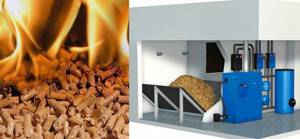
Pellets have high heat transfer.
Fuel briquettes
These products are also made from wood waste crushed to a powder form, which is then compressed. Depending on the type, such fuel looks like a brick, cylinder or tablet.
After the combustion of briquettes, about 1% ash remains, and the heat transfer reaches 5.8 kW/h, which gives them the opportunity to compete with firewood. If bark is used instead of wood chips in the production of this type of fuel, the listed advantages are neutralized.
The disadvantage of briquettes is that under inappropriate storage conditions they quickly gain moisture, resulting in reduced heat transfer.
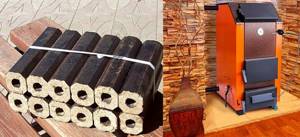
Fuel briquettes are also perfect for solid fuel boilers.
Coal
Of all types of solid fuel, it is the most efficient energy carrier.
Coal is:
- stone;
- brown;
- anthracite (it is rarely used for heating a house, because when burned it creates too high a temperature and is expensive).
When using a modern TT boiler to heat a small building, you will need 1 bucket of coal per day.
Disadvantages of this type of raw material:
- High price.
- When stored in large piles there is a risk of spontaneous combustion.
- When it burns, a lot of ash is formed, so the boiler will have to be cleaned more often.
The heat transfer of coal is 2 times higher than that of wood, so to maintain a given temperature in the house you will need less of it than even well-dried firewood.
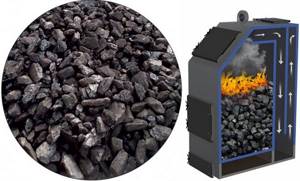
Coal for solid fuel boilers requires a certain fraction.
Peat
This type of natural fuel was formed over many years as a result of the decay of plants. The process took place under conditions of high humidity and with minimal access to oxygen.
Thus, a special layer of soil was obtained, having a dense structure and good heat transfer. The more humus it contains, the darker the color of the fuel. After extraction, the peat is cut into briquettes, which are dried and sent to the consumer.
Advantages:
- low cost;
- simple storage conditions.
The disadvantage is that peat is mined in swampy areas, so purchasing it is beneficial for those who live nearby. Delivery to other regions increases the cost of such raw materials.
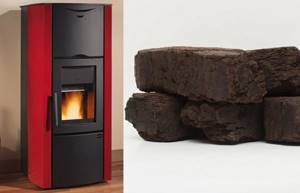
Peat for boilers cannot be found in all regions.
Design features
There are 2 types of TT boilers.
Kinds:
- Small-sized models. They are stoves with a small capacity for fuel. The storage is built into the top or side of the unit, similar to a combine harvester.
- Large boilers. These are fireboxes combined with bunker-type storage. Most often this is a separate room equipped for a woodshed or storage area.
In the first case, long-term autonomous heating of the house is excluded. The fuel in the bunker is enough for 6-9 hours, depending on the type of wood materials. In the second case, fuel reserves are limited only by the storage volume (the boilers are completely autonomous).
Differences from semi-automatic
When using TT boilers, the outlet temperature can be adjusted. Automatic installations, unlike mechanical ones, allow you to control not only the speed of rotation of the cylinders and blades when taking fuel, but also adjust the frequency of its loading.
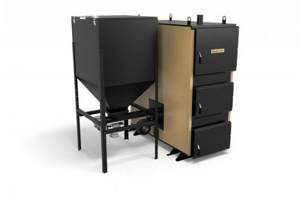
Automatic settings allow you to regulate the frequency of fuel loading.
TKDG is an autonomous equipment that excludes direct human participation in controlling combustion processes. The operation of the units can be fully automated, from ignition to temperature control, for example, in case of a long business trip.
TCDGs are capable of regulating the temperature of the coolant (in the heating system) and the environment (to protect against overheating). The optimal operating mode is configured using the remote control. If you integrate a GSM receiver into the module, the unit can be controlled using a smartphone.
Classic boilers
Standard type devices are designed to burn one type of raw material. Fuel is supplied to the furnace manually or automatically. The intensity of combustion and temperature will have to be controlled when using firewood. The raw materials are pre-cut and pricked. The process is automated by installing an electric knife in the compartment between the hopper and the combustion chamber. Peat and coal with 20% moisture content are crushed to the required fraction.
Briquettes and pellets from the store are ready for ignition, but they should be kept in a dry place.
When fuel is supplied, the storage becomes clogged with dust. This may damage the snack. To avoid breakdowns, already crushed fuel is poured into the storage. Coal must be sorted to prevent deformation of the chassis.
Combined
There are boiler models on sale that are suitable for burning wood, coal and pellets at the same time. This feature should be taken into account by residents of those areas where energy prices depend on the season. Thus, traditional firewood can be replaced with more affordable materials. In harsh climates, preference is given to cheap peat, coal, and pellets. Both firewood and crushed raw materials are suitable for heating houses in central and southern Russia.

Combination boilers are suitable for burning wood and coal.
A universal type of automated boilers is most often used in heating systems of houses. During the day, wood or coal is burned, and at night the installation is set to power supply (in order to save money). Combination boilers are also recommended for purchase when there are large seasonal temperature changes.
The use of firewood, coal or pellets has different effects on the efficiency of the equipment. So, in the summer, the premises can be heated with compressed sawdust, in the off-season - with peat, and in cold weather - with birch firewood, for example. To do this, the boiler design includes several bunker compartments and an additional burner, a heat exchanger (accumulator) for connection to the heating system.
Pellet
In boilers of this type, compressed granules from sawdust and shavings are used. Instead of pellet cassettes, wood chips and agricultural waste (husks, straw) are filled into the storage facility. The screw part processes a tank of fuel in 3-7 days. Despite the long autonomy of operation, the efficiency of the boilers is low (50-90%) and largely depends on the quality of the pellets. They must be dry, tightly compressed and contain at least 50% solid wood chips.
Pyrolysis
Boilers of this type generate energy due to the thermal decomposition of fuel. It is not the raw material itself that burns in the furnace, but the gas produced as a result of the pyrolysis process. The TKDG design is equipped with a built-in heat exchanger. Battery life increases to 1 month. Any solid fuel is suitable as fuel, but taking into account the manufacturer and model. In pyrolysis installations, you can configure auto-ignition and remote control.
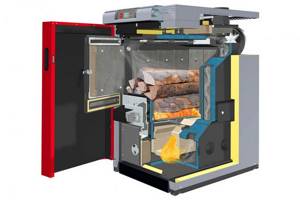
Pyrolysis boilers use the energy of fuel decomposition.
Solid fuel pellet boilers
If you purchase an automatic solid fuel coal boiler for a heating system that is inexpensive to operate, nothing will come of such an undertaking. But with a little ingenuity, TKDGs can save you a lot of money. To do this, we must remember that Moldova is an agricultural country. With a large amount of agricultural waste, especially sunflower husks.
Today the market offers an abundance of cheap husk pellets at a price of 2 rubles per 1 kg. But the main advantage of fuel from waste is its high heat transfer:
- on average, the calorie content of this raw material is 4500 kcal;
- if you compare husks with gas, then for 1 lei spent you get 2250 kcal of energy (from gas 1592 kcal);
- 30% - this is the saving you get if you heat with husk pellets.
The only problem is that not all coal boilers burn agropellets effectively due to the high ash content of this fuel. The units operate effectively on several types of solid fuel:
- fractional coal;
- fuel with a high composition of coal dust;
- agro-pellets;
- biomass of sunflower and corn.
The burner is independent of the fuel composition and copes well with the afterburning of pyrolysis gas and coking of the fuel. Unlike coal, agropellets produce 5-10 times less ash, and the kindling temperature does not go beyond acceptable limits.
How does an automatic TT boiler work?
The operating principle of TKDG is the same as that of a stove (fireplace). Fuel is supplied to the combustion chamber. During the combustion process, decomposition products are collected in the ash pan. Gases exit through the chimney (to the street).
The operation of an automatic boiler directly depends on the storage facility where the wood materials are stored. When purchasing, first of all, take into account its volume and method of loading raw materials. High-quality fuel with a fraction of 5-25 mm is used for bunkers with auger feed. There are no special requirements for raw materials for rotating drum storage facilities. Peat or coal is split and thrown inside.
Standard options
During fuel combustion, the TKDG generates heat. The energy is supplied through the pipes to the battery, which distributes liquid (water, antifreeze) throughout the radiator system.
The degree of heating of the pipes is regulated by the heat exchanger, and the combustion temperature and frequency of fuel supply are controlled by the TKDG itself.
Coal boilers
The operation of the installation is based on energy exchange: the coolant attached to a container with coal heats the radiator pipes. By circulating the liquid in a circle, the battery system heats up. The boiler controls the temperature in the specified mode.

Coal boilers are based on energy exchange.
The correct fuel fraction ensures uninterrupted operation of the TKDG. The device selects the heating mode taking into account the settings and amount of fuel. If a log or piece of peat does not pass into the combustion chamber, the operation of the unit will end. Fuel is poured into coal and pellet TKDGs 1-2 times a week, into wood-burning ones - daily.
Features of the design of industrial boilers
The equipment is characterized by increased dimensions and weight, which requires installation on a foundation. To burn fuel, a firebox with a grate is used, on top of which a boiler with heat exchangers is located. The flow of hot gases flows around the radiator pipes and ensures the heating of water or steam. The number and location of lines depends on the model and manufacturer. To increase operational efficiency, pipe packages are arranged in a staggered sequence with the installation of partitions between the risers.
Gases passing through the heat exchangers are collected at the rear of the housing and discharged into the atmosphere through the chimney. The height of the pipe provides natural draft and supports combustion. The boiler design includes inspection and technological hatches.
On hard and brown coal
The equipment is equipped with a forced gas exhaust system, but is not equipped with a fan to supply additional air to the firebox.

Hard coal and brown coal equipment is not equipped with a fan.
Boilers can operate on coal or brown coal; performance depends on the characteristics and moisture content of the fuel. A system for collecting ash generated during the combustion of solid fuel may be located in front of the smoke exhauster. Water is supplied using an electric circulation pump, supplemented by a make-up pump.
The chimney is installed on each boiler or on a group of devices connected in cascade into one module.
Wood burning
Such boilers are equipped with heat exchangers with constant circulation of liquid, which prevents local overheating and the formation of a layer of scale on the internal walls. To reduce energy losses, heat-resistant insulation of the housing and partitions of the combustion chamber is provided. The absence of cracks ensures stabilization of the oxidation process. There are sealed doors for loading fuel. The capacity of the firebox promotes complete combustion of firewood and prevents the release of residues with the flow of gases into the chimney and atmosphere.
The equipment is distinguished by a developed heating surface, which ensures a reduction in the temperature of combustion products to +200°C and an increase in efficiency. The ash is collected in a separate niche under the firebox and is periodically disposed of (for example, during routine maintenance). Boilers can reduce heating costs due to ease of use and increased efficiency of burning dry wood.
On pellets and sawdust
The equipment is equipped with automatic fuel supply mechanisms; the conveyor speed depends on the boiler settings. The raw material burns in a vortex chamber, the primary air flow enters the furnace under increased pressure created by the fan. The secondary vortex has a reduced pressure and ensures afterburning of sawdust or pellets. Fresh fuel is supplied by an air-cooled auger, which prevents fire in the bunker.
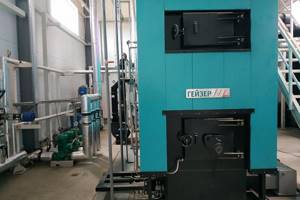
Pellets and sawdust burn in a vortex chamber.
Hot water and steam
Equipment is usually divided into categories according to the type of coolant. In classic water-heating boilers, liquid circulates in tubes, while in steam boilers, steam is heated. The temperature of the latter reaches +500°C at a pressure of 25 MPa and higher. Superheated steam can be used to drive turbine rotors (until the 50s of the last century it was used for double or triple expansion piston machines), and saturated steam, characterized by reduced parameters, can be supplied to the heating circuits of residential buildings or factory premises.
Types of fuel bunker
Loading devices for long-burning boilers are of 2 types: built-in and mechanized storage. The equipment of the unit affects the autonomy of operation and the very possibility of placing the installation. The area of individual bunker storage facilities in private homes can reach 20-50 m².
Built-in
Combine boilers are equipped with storage capacity of up to 1 m³. The container is mounted above the firebox or on the side of it. When choosing built-in bins, their height is taken into account. Fuel loading into an empty compartment must be carried out without interference. The higher the container, the more difficult it is to pour pellets and coal into it.
The advantage of built-in storage is its small size. Disadvantage: low autonomy.
Mechanized
Boilers with sleeve loading require separate storage of fuel in special tanks. They can be hanging canvases, free-standing boxes, frame pallets or entire utility rooms. The length of the hose providing the supply of raw materials should not exceed 10 m. During transportation, solid fuel crumbles, forming a lot of dust. This reduces the efficiency of the boiler.

A mechanized bunker involves storing fuel.
The advantage of mechanized storage is its capacity. The only drawback is the need for constant monitoring of the load (electrical wiring, sleeve attachments).
The dimensions of the bunker are responsible for the functionality and practicality of the boiler. The shape of the storage is selected taking into account the use of free space or volume. The design is purchased to order, taking into account fuel consumption. For example, 1 t of pellets is placed in a container with a volume of 2 m³. This amount is enough for 40 days. At standard fuel consumption (25 kg per day), one side of the tank should be at least 40 cm.
Top industrial solid fuel boilers
Good high-power water heating units can operate without operator intervention for 4–6 hours or more. Manufacturers provide electric heaters that do not allow water to solidify in the circuit when combustion stops or the fire dies out.
The equipment is designed for floor installation; there is a thermometer and a pressure gauge on the casing to determine the operating mode of the unit.
"KVR-Universal RT"
The KVR boiler is a floor-standing type; the line includes units with a power from 120 to 240 kW. Able to work on wood, coal and peat briquettes. Depending on the technical characteristics, it is suitable for rooms with an area of 1200 to 2400 m². To circulate the coolant, it is necessary to install an electrically driven pump. The heat exchanger allows you to heat the liquid up to +115°C and withstand pressure up to 0.6 MPa. The use of gray cast iron, resistant to external influences, made it possible to increase the service life to 25 years (with scheduled repairs).
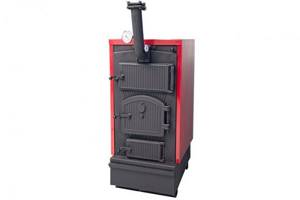
"KVR-Universal RT" is a floor-standing boiler.
"Kupper Pro 22"
The compact long-burning solid fuel boiler “Pro 22” has a low price, not exceeding 34 thousand rubles. The raw materials can be coal, briquettes or firewood. There is space for installing a gas or pellet burner. The operating time without adding a fresh portion of fuel is 8–10 hours. The kit includes an electric heater, a set of cleaning tools, a damper and a thermometer. The performance is sufficient to heat buildings up to 220 m². The plant guarantees uninterrupted operation of the equipment for 3 years.
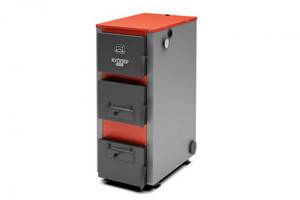
"Kupper Pro 22" is a compact long-burning boiler.
"Trayan TM 150"
The TM 150 boiler for industrial premises has an efficiency of 85% and is capable of heating buildings with an area of up to 1500 m² (with a ceiling height of no more than 2.7 m). The equipment can operate in cascades; briquettes, peat or dry firewood can be used as fuel.
The installation belongs to the pyrolysis category; a pipe with a diameter of 250 mm and a height of at least 13 m is required to remove gases.
When filling the circuits with antifreeze, it is necessary to install a circulation pump. The manufacturer claims the burning time of dry fuel is from 4 to 10 hours.
Automatic fuel delivery options
Loading of flammable materials into the chamber is carried out using 2 main mechanisms: screw and pneumatic. The feed hoses are powered by electricity. All solid fuel boilers are volatile.
Pneumatic conveyor
TKDG with a compressor are practical. The length of the flexible hose can exceed 10 m with sufficient engine power, which allows you to set up a bunker in an outdoor hangar. The pneumatic conveyor operates on the principle of a pump. After turning on the installation, pressure is created in the air pipe, and fuel is poured into the combustion chamber. The operation must be performed once a day (week) as fuel is consumed.
The main disadvantage of pneumatic boilers is their high electricity consumption.
Advantages – range, price, ease of installation.
Using augers
In TKDG with cylindrical screws, fuel is loaded continuously (according to the programmed program). The auger is located at the bottom of the bunker, which allows you to gradually process the entire stock of raw materials in the tank. After turning on the installation, the propeller, the blades of which are filled with fuel, begins to rotate, moving the mass into the firebox.

Using augers, fuel is loaded continuously.
The main disadvantages of screw boilers are the constant load on the electrical network and noise during operation. Advantages - durability, possibility of installation in technically combined utility rooms for conveyor loading.
Operating principle of top combustion boilers
Long-term operation of the devices is achieved thanks to a large fuel tank and a 2-stage combustion method.
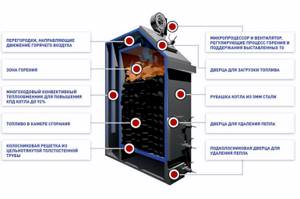
Design of a long-burning boiler with top loading of fuel.
The operating principle of the units is as follows:
- Firewood, coal or others are loaded into the compartment. Moreover, the tank itself is filled to the top. There is only a small space left for wood chips and branches for lighting.
- Using paper or a torch, set the bookmark on fire.
Since enough oxygen enters the compartment, active combustion begins. Gradually, when the fuel is completely engulfed in flames, air access into the chamber decreases. This process leads to slow smoldering of the raw materials, and subsequently to the combustion of the released gases. The fuel itself is processed into ash.
The efficiency of solid fuel units is achieved through maximum use of raw materials and heat generated in the process.
At the beginning of the gas combustion compartment there is a draft regulator. It automatically determines the temperature of the liquid and normalizes the combustion rate of volatile components.
The main principle of control of such devices is the regulation of air entering the chamber. The thermostat is adjusted to the required coolant temperature. And when the liquid heats up to the desired level, the damper is set to a different position, reducing the intensity of smoldering.
It is impossible to sharply increase the temperature unless the boiler is equipped with special fans for pumping air. In this case, the combustion intensity increases intensively, but more fuel is burned.
What fuel to use for a long-burning boiler
The choice of combustible materials must be rationally justified, taking into account practical benefits. When purchasing TKDG, take into account the following points:
- Pellets are the most powerful source of energy in TT boilers. The raw materials are environmentally friendly and do not require processing. The price is comparable to the cost of firewood.
- Coal and peat are the cheapest energy sources. They leave a lot of soot behind during the combustion process. Raw materials require grinding to the desired fraction, a special ignition technique that prevents smoldering. In terms of heat production, the materials are inferior to firewood.
- Wood is a traditional source of energy, environmentally friendly and inexpensive. Firewood produces a lot of ash and requires preliminary preparation to fit the size of the firebox.
These parameters should be taken into account when choosing a boiler for heating or heating.
Choosing fuel for solid fuel boilers
The type of heating device, the requirements for the entire energy supply system, make it possible to determine how to heat a home solid fuel boiler, which fuel is better. The question of whether it is possible to heat the apparatus with different types of fuel cannot be answered unequivocally. It all depends on the type of heating device. The operating principle of the equipment determines the choice - coal, firewood, coke and pellets, which we have access to today.
The performance of the unit depends on what fuel is used in the system and what quality it is. Moreover, the supply of fuel resources is made in large quantities; therefore, preparation for the heating season is associated with large expenses.

The most common types of fuel used in everyday life are:
- firewood;
- coal, hard or brown;
- pressed peat or wooden eurobriquettes;
- pellets.
If it is difficult to decide what and how to heat the heating unit, the best option is to use peat briquettes or heat with pellets. This fuel is ready for use and has the necessary physical characteristics. The only disadvantage of this type of fuel is the high price.

*
Firewood also has high technological characteristics. But here you should adhere to a strict rule :
For heating at home, it is better to use only hard wood. They burn longer and have high heat transfer. Try not to use pine wood for lighting. They have increased resin content, which leads to rapid contamination of the combustion chamber of the apparatus and the heat exchanger. Firewood must be dry. Firewood with high humidity burns worse; during the combustion process, a large amount of steam is released, which turns into condensate.
Coal is convenient, practical and beneficial in many ways. In addition to its affordable price, coal has high technological characteristics. This includes a long combustion duration and high heat transfer. When burned, coal emits a minimum of harmful substances.
Requirements for installing an automatic TT boiler
TKDG is operated taking into account fire safety rules and technical installation standards.
Requirements:
- Availability of a ventilation shaft (2 pipes for oxygen access and gas exhaust). The diameter of the holes is at least 10 cm.
- Equipment of the podium for the boiler. Material – steel sheet with a thickness of at least 3 mm or a cement foundation. Coverage area – at least 7 m².
- Use of non-combustible materials for finishing walls, ceilings, floors. Thermal protection of seams in places where the chimney is attached to the roof is mandatory.
- The installation distance to the walls is at least 50 cm. End-to-end corner installation is prohibited. The minimum perimeter of the box for the ventilation shaft is 20x20 cm.
- Installation of an expansion tank to discharge excess coolant (in the attic). In its absence, the heating system pipes will rupture and the boiler will explode.
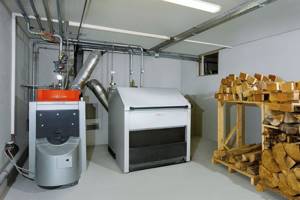
An automatic TT boiler must have a ventilation shaft.
Before installing the TKDG, you need to call a specialist to your home who will suggest the best option for placing the unit.
Boiler accessories
For greater heat transfer from TCDG, air flows and liquid are brought to the desired temperature or state. This allows you to extend the life of the unit and reduce energy consumption.
Auxiliary equipment:
- Fuel supply system (grabs, conveyors).
- Draft cleaning mechanisms (smoke exhausters, fans, flues, air ducts).
- Ash and slag removal structures (crushers, bunkers, conveyors, ash collectors).
- Pumping equipment (for feeding coolant, filling the water circuit, etc.).
- Separation devices for water treatment (filters, deaeration unit).
- Automation systems (measuring instruments, sensors, electronics).
The latter allow you to program ignition, set up automatic collection of ash into a container, connect a battery, control the installation remotely, and select temperature modes.
Coolant temperature
An important point is maintaining the specified temperature of the coolant in the system. Several basic parameters. Parameter one. The coolant temperature must always be above 65° C, otherwise condensation will form in the boiler from water vapor and combustion products, these are acids that destroy the heat exchanger. Second parameter.
In systems with forced circulation of coolant, when the electricity is turned off, a temperature difference occurs in the boiler and heating radiators; when turned on again, this can lead to cold water from the return causing “temperature shock”, thermal shock and leading to deformation of the heat exchanger, this is especially critical for cast iron heat exchangers.
Parameter three.
Inertia. In solid fuel boilers it is very difficult to maintain the specified coolant temperature. This is especially true for traditional boilers. Therefore, several solutions are used. One of them is a cooling heat exchanger. It can be either built into the boiler or external. In steel boilers, as a rule, an independent cooling circuit with a coil is installed. In cast iron boilers, the cooling circuit is external and is equipped with a thermal valve or shut-off valve. The second solution is to install a storage tank. This allows you to regulate the temperature of the coolant in the system, increase the efficiency of the solid fuel boiler and reduce overall fuel consumption.
Choosing a boiler with automatic fuel supply
The operational characteristics of the units help to narrow down the search for the right model. If you have a limited budget, it is advisable to choose boilers taking into account the following parameters.
Dimensions
The dimensions of the TKDG must correspond to the area of the room in which the boiler room is planned to be installed. The dimensions of the unit affect the autonomy of operation. The larger the bunker can be mounted next to the firebox, the more practical the installation will be. The volume of the combustion chamber for solid fuel must be at least 80 liters (8-12 hours of operation at a power of 20 kW). The larger the firebox, the higher the efficiency of the boiler.
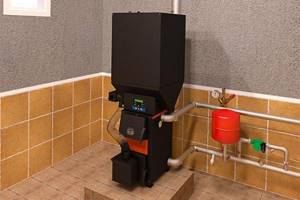
The dimensions of the boiler depend on the area of the room.
Heat exchanger material
As a result of temperature changes (when the device is turned off), the walls of the coolant compress and expand. The degree of metal deformation and the service life of the boiler depend on the alloy used.
Steel structures can last up to 15 years. The metal is durable, heats up quickly, and withstands temperature changes better. The weak point of steel heat exchangers is the welding seams and the place where the chimney is attached. Poor installation causes frequent breakdowns.
Cast iron structures last up to 20-25 years. The alloy is durable, but can burst due to sudden temperature changes. The material warms up slowly, but is excellent for organizing uninterrupted boiler rooms, because... not susceptible to corrosion. A cast iron heat exchanger can be used without water filtration. Alloy boilers are demanding on the return flow fluid temperature. Therefore, water circulation in the system is started after it has been preheated.
Boiler power
The amount of heat generated depends on this parameter. Boilers operate in several modes. The choice of unit is made taking into account the power range (from minimum to maximum), which affects the amount of electricity consumed. If the boiler operates in 5-30 kW modes, then with one load of fuel (4-12 hours) it will be possible to generate at least 20-60 kW. The network power of the unit is selected taking into account the power supply circuit of the house. In some cases, it will be necessary to replace the meters and run a separate wiring cable to the boiler room.

The boiler power affects the electricity consumed.
Safety
Fire safety parameters of boilers are confirmed by international quality certificates.
The equipment supports operation:
- In the event of a power outage (emergency circuit in the TKDG harness, uninterruptible power supply battery).
- In the event of a breakdown of the boost fan (overheating protection valve).
- When the feed pump is jammed (forced circulation of liquid in the heat exchanger).
- In case of boiling of the coolant (thermostat), increase in pressure in the tank (water and gas discharge valve).
- When liquid circulation in the circuits stops (TT boiler safety group, separate heat exchanger).
This is not enough for a demanding buyer. For safe operation, the unit is equipped with a control module. Program settings allow you to use frost protection (in winter), automatic temperature and ventilation modes, self-regulating ignition (pyrolysis boilers).
Noise level during operation
Boiler units are noisier than gas heaters. Massive installations with hose fuel supply from the bunker create additional inconvenience (sounds of the pneumatic pump, engine, feed mechanisms).
There are several solutions to the problem:
- soundproofing the room;
- purchase of a boiler with a changeable supply mode;
- inclusion of an electric heating element in the heating system, which will heat the house at night.
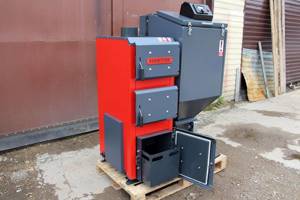
An automatic solid fuel boiler is noisy.
Small-sized TT-boilers using pellets are comparable in noise level to stoves.
Fuel used
Raw materials for ignition are selected taking into account prices in the region of residence. Special attention is paid to the fuel moisture indicator, which affects energy production. Fuel efficiency decreases by 20-30% when using damp firewood. The optimal fuel humidity is 25-30%, like pellets. In this case, the heat generation reaches its maximum, but the amount of carbon deposits also increases (cleaning is needed). The manufacturer indicates the boiler power taking into account the use of non-raw fuel. The efficiency of the unit largely depends on the quality of the fuel.
Autoignition
The delayed heating start function is provided only in pyrolysis boilers, which are several times more expensive compared to classic models. Auto-ignition is an unnecessary option for home use. Fuel is loaded continuously, the fireplace burns constantly.
Manufacturers have provided the possibility of delayed heating for consumers who heat their homes at night, in the off-season, or simply want to spend the weekend in a warm home.
When choosing an automatic ignition, take into account the type of mechanism that lights the flame (timer, temperature sensor, GSM module).
Cost-effectiveness and energy dependence
The heat transfer of wood, coal and pellets differs from each other. To get the same power from one bookmark, peat and sawdust, for example, need to burn for different amounts of time. The heat transfer of materials will differ, which will affect costs in monetary terms. 1 ton of pellets can replace a trailer of firewood in terms of calorific value. At the same time, the consumption of materials per unit of time differs. Taking this feature into account, the most efficient energy carrier is selected.
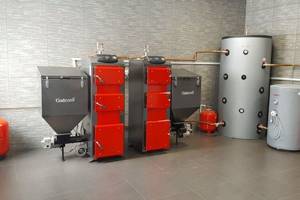
The consumption of different materials for the boiler is different.
Any TKDG or its module combined with a boiler room operates only from the mains. Setting up a non-volatile unit is expensive, because... You will need several powerful batteries and additional equipment for supplying current.
However, in emergency situations, backup power to the boiler will not hurt. The battery should be selected taking into account the battery life.
Efficiency
The indicator determines the rated power (heat transfer) of the unit and is 80-90% with proper operation. Because the boiler can be used constantly or periodically; low efficiency each time the system is started will hit the pocket, increasing fuel and electricity consumption.
Remote control
GSM controllers program boiler operating modes and notify the owner when critical (pre-emergency) values of several indicators are reached at once. For operational management purposes, the buyer should pay attention to the number of available SIM cards (providers), a set of commands, and the ability to analyze statistics online through a browser.
How to calculate boiler power
SNiP 2.04.01-85 – technical guide for installing TT boilers. According to a simplified scheme, the heating power is calculated at a rate of 1 kW per 10 m² (with ceilings up to 3 m, brick walls laid in 2 rows). The total area is divided by 10 and the required power is obtained. Additionally, the degree of insulation of the house, heat loss, inaccuracies taking into account the complex layout, and the presence of hot water circuits are taken into account. The margin for each parameter should be 10-20%.
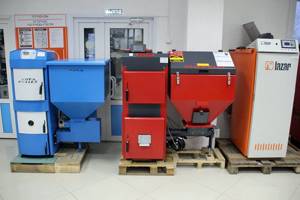
Heating power is calculated using the technical manual.
When the power is overloaded, the boiler becomes underloaded. It can be eliminated by connecting additional equipment.
If there is a lack of power, the rooms will not warm up, and the system will need to be redone.
The best solid fuel boilers with automatic fuel supply
The range of boilers and bunkers allows you to equip boiler rooms to suit your needs.
Metal-Fach SMART Auto ECO 20
Efficiency – 90%. Remote control with automatic security group. Heated with sorted coal and wood. Storage reserve – 5 days. Power is 6-20 kW.
Galmet Duo 17
Efficiency – 86%. Remote control with overheating protection, handheld programmer. Heated with coal, briquettes and wood. Storage reserve – 12 days. Power – 3-17 kW.
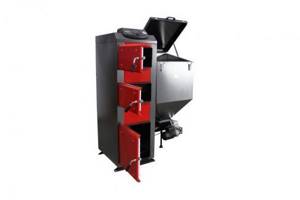
Galmet Duo 17 has an efficiency of 86%.
Zota Pellet 100A
Efficiency – 90%. Remote and manual control. Options - automatic ignition, ash removal, heat exchanger cleaning. Heated with pellets and wood. Bunker reserve – 10 days. Power – 5-100 kW. The unit is connected to a room thermostat.
Zota Optima 20
Efficiency – 85%. GSM control. Options: weather-compensated automatic. Can be heated with any fuel in manual mode. The reserve for one load is 1-2 days. Power – 5-20 kW. A heating element connection is provided.
ACV Tkan 100
Efficiency – 85%. Sensor system, manual control. Options - automatic ignition, ash removal, heat exchanger cleaning, overheating control. Can be heated with any fuel. Bunker reserve – up to 7 days. Power – 5-100 kW.

ACV Tkan 100 is a model with automatic ignition.
Wattek Pyrotek 36
Efficiency – 90%, power – 5-36 kW (pyrolysis). Sensor system, automatic control. Heated with wood and briquettes. Storage reserve – 1-3 days. Connection of a boiler and heat accumulator is provided.
Pereko KSP Duo 18
Efficiency – 95%. Sensor system, electronic control with safety group. It is heated with eco-peas, pellets, firewood, and brown coal. There is a chamber for burning wood. Storage reserve – up to 2 days. Power – 5-18 kW. Only heating equipment can be connected.
Heiztechnik Q Eko Lux 15
Efficiency – 88%. Sensor system. Options – remote control, burner auto-cleaning. Heated with coal and pellets. The reserve for one load is 2-4 days. Power – 5-15 kW. Connection of additional equipment is provided.
Boiler reviews
Alexander, 37 years old, Syzran
I bought Metal-Fach SMART OPTIMA 19 for boiler heating. I use firewood. One load is enough for 12 hours. The case is durable, steel. Mechanical control. Serves for 5 years without breakdowns.
David, 40 years old, Nakhodka
I use ZOTA Topol-M 30. A powerful unit that can withstand the connection of a heat accumulator. Compact, easy to clean. Large combustion chamber for 10 hours. The unit requires high-quality installation and proper piping. The disadvantage is the lack of a draft thermostat. I had to install it myself.
Sergey, 45 years old, Tula
Protherm Beaver 30DLO with a cast iron heat exchanger has a safety group with many sensors. The design is on par, but these characteristics turned out to be unnecessary during operation. Firewood burns out in 2 hours, you need to chop it finely. Efficiency is high. After 4 months, the cast iron section of the heat exchanger burst. The device is intended only for antifreeze approved by the manufacturer. Replacement of goods was refused. The second purchase was thought out to the smallest detail. For a 2-story house I took a Turkish Totem with a side bunker. A simple, silent unit.
TKDG is used instead of gas boilers for heating and space heating. Purchasing a unit is advisable if the storage capacity ensures long-term autonomy. The less often it is filled, the more convenient the operation of the boiler.
